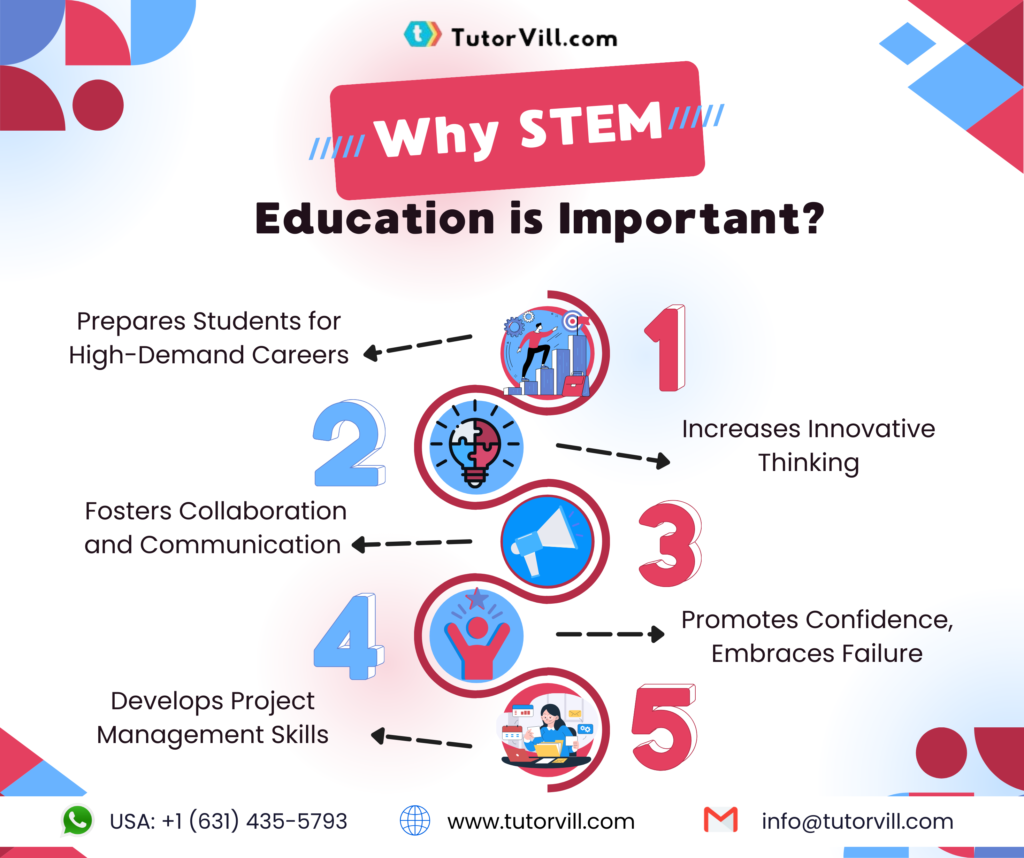Today, education is more than just about reading, writing, and arithmetic. It’s about preparing students for future challenges and opportunities equipping them with the skills and knowledge they need to succeed.
At the heart of this preparation is STEM education, which focuses on science, technology, engineering, and mathematics. In this blog, we will discuss the significance of STEM education for K-12 students, exploring its benefits, challenges, and best practices for implementation.
Experience Exceptional STEM Education with TutorVill: Get Your Free Trial Today!
Why STEM Education is Important
1. Enhancement in Thinking
STEM education focuses on developing analytical and critical thinking skills in students. Through experimentation, data analysis, and logical reasoning, students learn to approach problems systematically and find effective solutions.
This enhances their ability to evaluate information critically, make informed decisions, and adapt to changing circumstances in today’s world.
2. Closing the Gap
One of the most compelling reasons for prioritizing it is its potential to bridge the achievement gap between students in low-income school districts and their more affluent counterparts.
STEM system provides all students, regardless of their background, with the opportunity to develop critical thinking, problem-solving, and analytical skills. These essential skills help students to level the playing field and empower them to compete on equal footing in the 21st-century workforce.
Connect with Qualified STEM Tutors for Personalized Online Learning!
3. Promoting Teamwork
Collaboration and teamwork are integral components of STEM education. Students often work in groups to tackle complex projects, exchange ideas, and solve problems collectively. By working collaboratively, students learn to communicate effectively, share responsibilities, and leverage each other’s strengths.
This teaches students the value of cooperation—a skill essential for success in both academic and professional settings.
4. Fostering Creativity and Innovation
STEM education nurtures creativity and innovation among students by encouraging them to explore new ideas. Through hands-on learning experiences and real-world projects, students can tackle complex problems and develop inventive solutions.
By promoting a culture of curiosity and experimentation, this education system cultivates a new generation of innovators and change-makers to address the challenges of tomorrow.
5. Preparing for Future Careers
In today’s technology-driven economy, the demand for STEM professionals is higher than ever before. Job opportunities in STEM will grow significantly in the coming years, outpacing the average for all occupations.
By providing students with a strong foundation in STEM subjects, schools prepare them for high-demand careers in fields such as computer science, engineering, and healthcare. This not only opens doors to exciting job opportunities but also equips students with the skills they need to succeed in the job market.
6. Promoting Diversity and Inclusion
Diversity and inclusion are essential principles of STEM education. By emphasizing STEM learning, educators can empower underrepresented groups, including girls, minority students, and those from disadvantaged backgrounds, to pursue STEM careers.
Increasing diversity in STEM fields brings fresh perspectives, and promotes a more inclusive society.

7. Addressing Societal Challenges
STEM education equips students with the tools to tackle complex societal challenges, such as climate change, healthcare disparities, and technological advancements.
By nurturing a diverse group of STEM professionals from all backgrounds, schools can bring different experiences and perspectives to the table, leading to more comprehensive solutions that benefit all communities.
8. Instilling Management Skills
It instills important management skills in students, such as time management, organization, and project management. As students engage in various STEM activities, they learn to plan, coordinate, and execute tasks efficiently.
Whether it’s organizing a science fair project or coordinating a robotics competition, students develop essential management skills that are transferable to future endeavors, including academic pursuits and career opportunities.
Elevate Your K-12 STEM Education: Learn Online with TutorVill!
Best Practices to Promote STEM Education in K-12 Schools
Implementing STEM education in K-12 schools can be challenging, especially in areas with limited resources. However, there are several best practices that schools and educators can adopt to enhance access to quality STEM education:
Partnerships and Grants
Collaborate with local businesses, colleges, and nonprofits to secure funding, equipment, and volunteer opportunities for STEM education. Additionally, schools can apply for grants focused on STEM education at the local, state, and federal levels.
Teacher Training
Invest in professional development opportunities for teachers to enhance their knowledge and skills in STEM subjects. Online training, workshops, and peer mentoring programs can help educators feel more confident and competent in teaching STEM concepts.
Integrate STEM Across the Curriculum
Instead of confining STEM education to science or math classes, integrate STEM principles into humanities, arts, and physical education. This interdisciplinary approach helps students see the relevance of STEM in all aspects of life and encourages cross-disciplinary learning.
Dive into the World of Math for K-12: Enroll Now for Expert Math Tutoring!
Project-Based Learning
Engage students in hands-on, real-world projects that apply STEM concepts to solve practical problems. Project-based learning fosters creativity, critical thinking, and collaboration skills while making STEM subjects more engaging and relevant to students.
After-School and Summer Program
Offer after-school and summer programs that provide additional exposure to STEM topics through coding clubs, robotics competitions, and science fairs. These programs complement classroom learning and allow students to explore STEM subjects in more depth.
TutorVill: Empowering K-12 Students Through STEM Education
TutorVill plays a vital role in advancing STEM education for K-12 students through:
- Expert Tutors: Our highly qualified tutors specialize in STEM subjects, delivering personalized instruction to ensure students grasp complex concepts effectively.
- Comprehensive Curriculum: Aligned with educational standards, our curriculum covers mathematics, science, technology, and engineering, providing a solid STEM foundation.
- Interactive Learning Platform: Our platform offers engaging lessons, hands-on activities, and multimedia resources, fostering curiosity and active participation.
- Personalized Learning: Tailored to individual needs, our tutors create customized learning plans, offering extra support or advanced coursework as required.
- Continuous Support: We provide ongoing assistance and feedback, helping students overcome challenges, build confidence, and track their progress effectively.
Through these efforts, TutorVill inspires a new generation of innovators and problem-solvers, equipping them with the skills to excel in STEM fields and contribute meaningfully to society.
Prepare for STEM Success: Join our K-12 Program Now!
Conclusion
STEM education is essential for preparing K-12 students for success. By closing the achievement gap, fostering creativity and innovation, preparing students for future careers, promoting diversity and inclusion, and addressing societal challenges, STEM education empowers students to reach their full potential.
By implementing best practices and prioritizing access to quality STEM education, schools and educators can ensure that all students can develop the skills and knowledge they need to thrive in an increasingly complex and interconnected world.
TutorVill is committed to contributing to this mission by providing high-quality STEM education to K-12 students worldwide.
